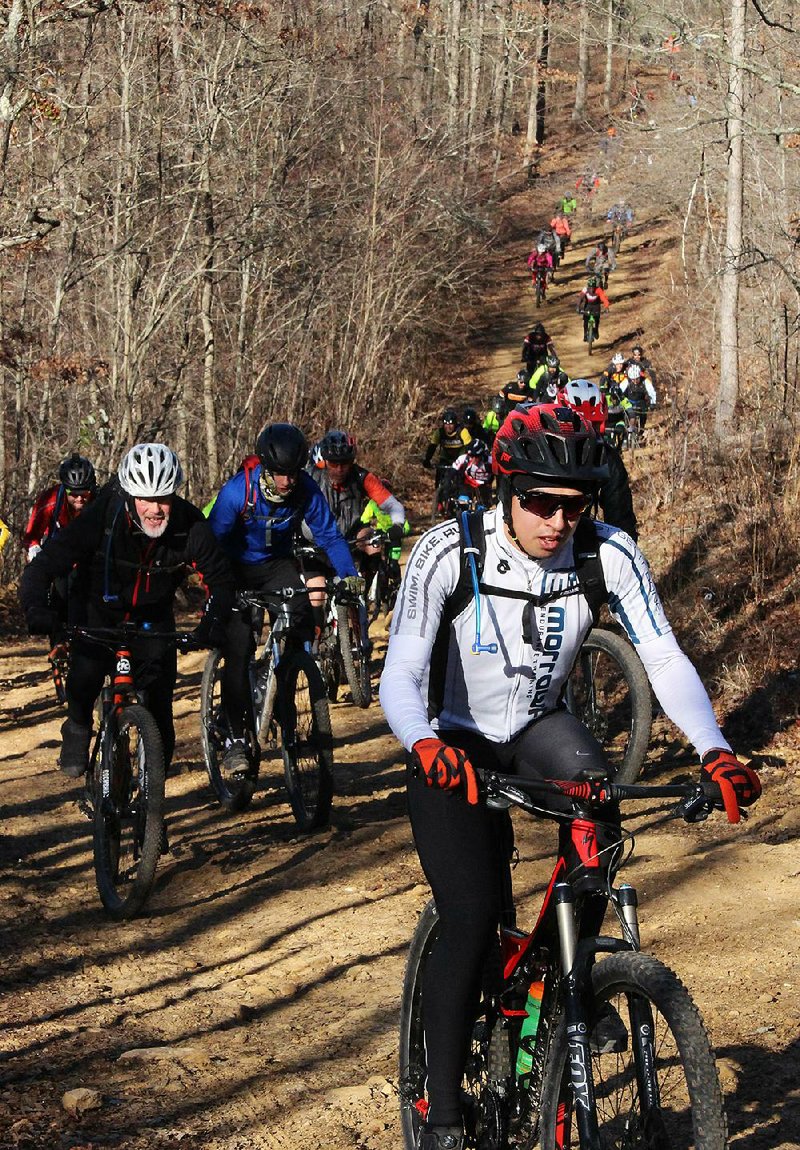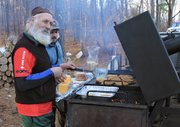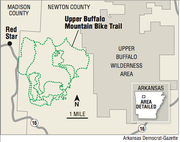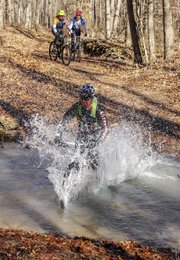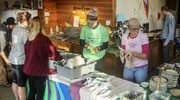MADISON COUNTY -- Members of the Ozark Off Road Cyclists celebrated 20 years of volunteer trail advocacy while hosting their 12th annual Buffalo Headwaters Challenge near the Upper Buffalo Wilderness Area.
Their fun began the evening of Jan. 27 with a meal prepared by volunteers of the small private Headwaters School in unincorporated Red Star, followed by a tribute to the group's founders, who reminisced about the early years.
In the late 1980s the sport of mountain biking was introduced to Northwest Arkansas by Devil's Den State Park rangers and independent bike shops like Highroller Cyclery in Fayetteville and Ozark Bike Shop in Rogers. As riders began swapping skinny tires for knobbies, the bike shops became places to congregate.
As they gathered to share mountain biking stories, it quickly became apparent that each of them also shared a common problem -- where to ride. Tim Scott, assistant park superintendent at Devil's Den, and then-Superintendent Wally Scherrey had developed some off-road paths at the park that were the only officially sanctioned off-road bike trails in the area. People also biked on trails built on their property or on old logging roads.
As more riders joined the collective, they started to notice that each newcomer seemed to know about new trails. In the interest of having more places to ride and more like-minded individuals to ride with, they formed a club.
In February 1997, four riders gathered at Cable Car Pizza in Fayetteville and named themselves the Ozark Off Road Cyclists. They elected David Renko as president.
Renko, then 29 and an experienced mountain biker and trail builder, was a perfect fit to jump-start the organization. As a member of the Cate Brothers Band, a popular country-rock group from Fayetteville, his days were much pretty open. He had time to scout routes and lead rides.
"I liked to study topo maps of federal land to locate where the lines were squashed together, because that's where the fun is going to be," he says.
By June of that year, club membership was at 46, and by December it had grown to 96.
In those early years, the group focused on building a community of off-road cyclists by scheduling weekly local rides and monthly rides that ventured into the Ozark and Ouachita mountains. To encourage riders of all skill levels to participate in these adventures, they followed a "no rider left behind" policy.
As the number or riders grew, conflicts with other trail users convinced them that, for mountain biking to grow, the club had to become involved in building and maintaining the trails. So in addition to regularly scheduled club rides, their calendar began including trail work days.
From that commitment, it was a natural step for Ozark Off Road Cyclists to become the advocate and political force for bicycle trail access that it is today.
THE HEADWATERS TRAIL
There was no more appropriate place for the club to celebrate its 20th anniversary than the picturesque and remote Upper Buffalo trails. The group's ties to these woodland paths was cultivated even before the club was a club.
As Tim Moore, a Highroller Cyclery employee at that time, explains, "We were in the shop one day when Ira and Gala White brought their bikes in to be worked on. The bikes were totally trashed, with broken derailleurs, loose headsets, pedals about to fall off and a mismatched array of other broken components."
Moore asked where they had been riding to have inflicted such punishment on their machines. The brothers told him about trails their community near Red Star was building in the headwaters of the Upper Buffalo River drainage area.
Shortly afterward, Moore and several other bikers visited the Whites' homestead to camp and check out the trails. They met How Kuff, a neighbor who had been instrumental in establishing the network of trails.
As Kuff led the group on rides through deep hollows and over tall, wooded ridge tops, he explained that in the 1920s this land had been privately owned and home to more than 100 homesteads. Many of the trails they were riding had been residents' routes to town or to neighbors' houses. (See "Forest Service opens Upper Buffalo trail," in the June 30, 2014, Arkansas Democrat-Gazette.)
Back in Fayetteville, they talked about the Upper Buffalo area with fellow mountain bikers, and soon, with Kuff as their guide, the headwaters became a regular outing.
LET THE RIDE BEGIN
With temperatures hovering around freezing the morning of Jan. 28, and after "carb loading" on a hearty breakfast (prepared once again by Headwaters School volunteers), about 450 diversely attired mountain bikers lined up to take on the 12th annual Buffalo Headwaters Challenge.
Riders had their choice of The Challenge, a 40-mile-ish marathon of a ride with more than 4,700 feet of elevation gain; the Half Challenge, a 26-mile adventure with a mere 3,000 feet in gain; or the Half-of-a-Half Challenge, a 17-mile, enjoyable jaunt through the Ozark forests (elevation gain unmeasured).
No matter which route they selected, everyone experienced the same starting challenge, a 1 1/2-mile, 500-foot climb up a rocky logging road. Whew! Not my preferred terrain for warming up cold leg muscles.
Shortly after that climb topped out, the route ducked into dense woods and dropped cyclists onto a long, single-track thrill ride down the side of a mountain.
For those who have yet to experience the rush of a single-track descent via bike, it's a combination of riding a roller coaster and being an Imperial Army trooper in the classic speeder-bike chase from Star Wars: Episode VI -- Return of the Jedi. Remember literally swaying from side to side in your theater seat as you watched the troopers chasing Luke and Leia, narrowly avoiding trees? Throw in the occasional air time as your bike crests a dirt mogul, and you've captured the sensation of mountain biking in the Ozarks.
At the bottom of a deep hollow walled in by heavily wooded mountains, the trail took riders along the banks of an emerald stream. This beauty was interrupted by the occasional wet and cold crossing of said stream. And then we were routed back uphill on long, steep, thigh burning, seemingly endless climbs.
An undulating circuit of climbs and descents repeated again and again throughout the Headwaters Adventure. At some of the creek crossings, the water was thigh high, becoming even deeper for those who were unable to keep their bikes upright during slippery, rocky, abrupt climbs out of the creek and up its steep banks.
As Kate Kuff, one of the organizers, put it, "This is not a walk in the park, this is a challenge."
By the end of the day, everyone had earned the recovery meal, which featured "the legendary grilled cheese sandwich," local craft beverages and an evening of music within the warm confines of the schoolhouse ... to be followed by more socializing around a bonfire that blazed late into the night under a star-filled sky.
One person I spoke to beside the fire ring likened the annual challenge to the mountain man rendezvous of the early 1800s, when kindred spirits gathered to reminisce with friends who understood what drew them to their unique lifestyle.
BUT WAIT ... THERE'S MORE
On the morning of Jan. 29, as advertised, the club turned the dial to "rowdy," introducing riders to their first Hoot 'N' Holler enduro-inspired mountain-bike experience.
This ride consisted of a screaming three-mile descent on one of the trail's more raucous single-tracks, Firetower Trail, followed by a shuttle back to the top of the mountain in Phat Tire Bike Shop's "Hillbilly Gondola." Riders could repeat the descent, again and again and again, until their fun meter maxed out.
Brannon Pack, club executive director and a board member since 2014, says the Firetower Trail event was created to engage young riders.
"The Hoot 'N' Holler is an event that is catering to the next generation of mountain bikers, whose racing style is changing. As riding style changes, we have to change with it in order for the organization to grow," he says.
He sees this generation as the next wave of trail advocates. A good indicator that the trap is set was the 30 young people who showed up just to do the downhill event.
BRANCHING OUT
During 2014, the club, which is a chapter of the International Mountain Bicycling Association, went through a strategic planning process to set three- to five-year goals.
As a result of this study, they realized that, with more than 600 members, the club couldn't grow at the rate it had in recent years and advocate for trails without full time, paid personnel. Someone needed to be available to work with state and local government leaders and advocate for the vision of trail networks as important to a community's quality of life.
Bruce Alt of Little Rock, vice president of government relations for IMBA, praises the hiring of Pack, a Springdale resident with managerial experience. Only 17 of IMBA's 215 chapters nationwide have paid staff, Alt notes.
Also, Alt says, Ozark Off Road Cyclists is the only IMBA chapter that's deliberately branching into other communities to expand its membership. Creating branches in Fort Smith, Russellville and Eureka Springs makes it less expensive for cyclists in those areas to join IMBA.
More information about the club and its branches is at ozarkoffroadcyclists.org.
Bob Robinson is the author of Bicycling Guide to Route 66, Bicycling Guide to the Mississippi River Trail and Bicycling Guide to the Lake Michigan Trail (spiritscreek.com).
ActiveStyle on 02/13/2017
